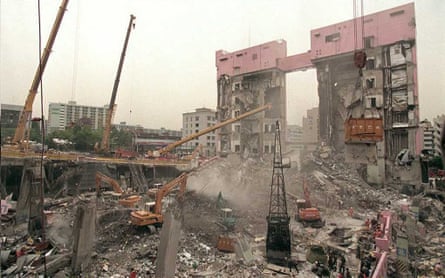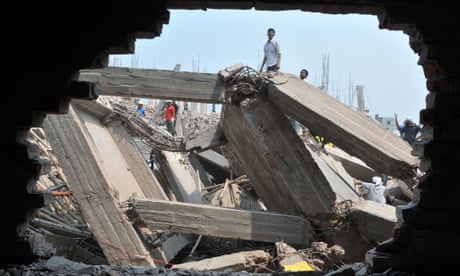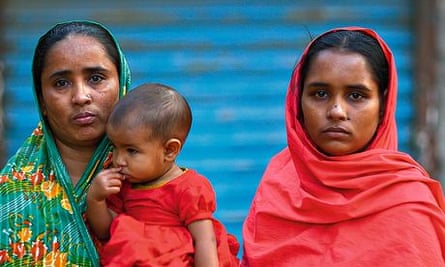Learning from Seoul\’s Sampoong Department Store disaster – a history of cities in 50 buildings, day 44This article is more than 10 years old
After a string of ill-considered decisions led to the collapse of Seoul’s luxury department store and the death of 502 people in 1995, the disaster continues to offers an important lesson to other cities urbanising at such an impressive pace
Colin MarshallWed 27 May 2015 14.27 BSTShare 16
Observers tend to describe the rise of South Korea as a miracle, and the actual story makes the word seem only a minor exaggeration. Having emerged an utter wreck from the Korean War in the early 1950s, by the 21st century the country had become a rich, infrastructurally impressive, technologically forward-thinking global economic and cultural force. But South Korea’s unprecedentedly rapid entry into the first world has taken its tolls, and no one event of its dizzying 20th-century period of growth forced as many of its people to face them as the collapse of the Sampoong Department Store.
Those who endured the hardships of the Korean War and its aftermath had to welcome whatever prosperity the future could bring, despite the repression of the dictators who oversaw it and the grinding nature of a national life rigorously dedicated to nation-building. But from the 1970s through to the early 1990s, even the most development-minded Korean couldn’t help but suspect that something had gone wrong. An apartment block falls to the ground, a hotel catches fire, a train station explodes, a bridge collapses: the built environment that had risen so recently and triumphantly around them had already begun to crumble.
From the beginning, South Korea has understood that development and urbanisation go hand in hand. In fact, it understands that almost too well, resulting in what ranks today as one of the most capital-centric countries in the world. The resources it has devoted to Seoul make the rest of South Korea seem almost like a mere support system for that 24-hour high-rise megalopolis of 25 million people, built over the rubble of the modest Japanese colonial city it had been before the second world war.
The creation of postwar Seoul involved plenty of rebuilding, but even more new building. The “old” city lies north of the Han River, which runs through Seoul much as the Thames does London. On the Han’s other side, the area known as Gangnam (literally, “south of the river”), made famous in recent years by pop music and television dramas, has grown since the 1970s as a deliberately designed hub of private affluence, corporate investment, and skyline-defining towers – a concrete advertisement for just how far up South Korea has come in the world.
A former landfill in Gangnam’s especially wealthy district of Seocho made the perfect location for the upscale Sampoong Department Store. Construction on this bright pink symbol of Seoul’s advanced consumer culture began in 1987, the year South Korea became a democracy and the year before the modernised country made its debut on the world stage by hosting the Olympic Games.

US and South Korean soldiers look for survivors in the rubble: 502 people died, and almost 1,000 were injured in the collapse. Photograph: Choo Youn-Kong/AFP/Getty Images
But it didn’t enter construction as a department store: the original plan called for a large four-storey apartment complex. After work had already begun, owner Lee Joon, in the first of many ill-considered decisions, switched the project from a residential one to a commercial one, a conversion which necessitated the removal of support columns to make room for escalators. When the contractors balked at this, Lee exchanged them for a more obedient in-house crew.
Using a building of this size entirely as a department store went against zoning regulations, which Lee circumvented by ordering the addition of a skating rink on an originally unplanned-for fifth floor. Again, when the first building company he hired advised against such a structure-compromising modification, he simply sacked them. The firm that did build the fifth floor even went along when he changed his mind once again, turning it into a gallery of restaurants heated by a system of under-floor hot-water pipes, increasing the stress on the already overburdened columns remaining.
Still, the Sampoong Department Store might stand today if not for the air-conditioning machinery installed on top. When tenants of neighbouring buildings to the east complained about the noise it made, management moved the three units to the west, not by lifting them with cranes, but by dragging them – their combined 45-tonne weight four times what the building was designed to handle – all the way across the roof. This opened up cracks that widened each and every morning the air conditioners clicked on and vibrated to life over the next two years.
Then came the morning of 29 June 1995. The structure’s visible cracks had widened alarmingly and continued to do so as the day wore on, provoking enough concern to force two executive decisions: first, to switch off the air conditioning, and second, to close the top floor. But Lee refused to evacuate the day’s unusually large and lucrative shopping crowd, and so in the store they remained at 5:52 pm, when the air-conditioning units fell through the roof and the support columns gave way, resulting in the deadliest building collapse since antiquity.

View image in fullscreenInspections after the collapse revealed that just one-in-50 of Seoul’s towers were safe. Photograph: Kim Jae Hwan/AFP/Getty Images
More than 500 people died in the Sampoong Department Store – not because of a gas explosion or a North Korean bomb (two early suspicions) – but because of sheer negligence in construction and maintenance of a building not yet six years old. As the facts emerged, Lee and his associates became the most reviled men in South Korea, not just for their own actions (most damningly, their selective evacuation of Sampoong’s executives from the building, hours before the collapse) but for the shameful strain they represented in the country’s modern history: their reckless corner-cutting, bribery and irresponsibility, far from isolated tendencies, had become endemic in a society desperate to develop as rapidly as possible, a sensibility which renders the law nothing more than an obstacle to prosperity.
“Endless Disaster, Disaster, Disaster,” declared one local headline in the wake of the Sampoong collapse. Not only had the public caught on to that pattern, but the investigation of the Sampoong Group and the government officials with which they dealt threw light on a staggering depth and breadth of corruption. Worse still, the thoroughgoing inspection of Seoul’s by then proudly characteristic towers found that one out of seven needed rebuilding, four out of five needed major repairs, and just one in 50 could qualify as safe.
“People should do their best at their jobs,” said Jeong Gwang-jin, a prominent lawyer who lost three daughters in the Sampoong Department Store. “This accident happened because they didn’t.” The prioritisation of size and quantity over safety and quality demanded by South Korea’s ideology of accelerated nation-building, expressed as a practice of accelerated city-building, visited this resoundingly third-world accident on Seoul’s newly minted upper-middle class.
 Reliving the Rana Plaza factory collapse: a history of cities in 50 buildings, day 22Read more
Reliving the Rana Plaza factory collapse: a history of cities in 50 buildings, day 22Read more
And Lee, born in 1922, would have come of age in a time when Korea was a land that still relied to a great extent on horse carts and thatched roofs, one where nobody considered the prospect of opulent shopping complexes, let alone of the prospect of opulent shopping complexes suddenly falling down. Like most of South Korea’s ruling class in the 1970s and 1980s, Lee found himself in a position of power in a reality almost incomprehensibly different from any he’d known before, with a mandate only to generate wealth, and he made decisions that reflected his circumstances.
The story offers a lesson to all the cities currently and dramatically expanding in developing countries over the world, most notably China, where the impressive and frightening aspects of South Korea’s development now play out on a larger scale and shorter timeline. It also continues to offer a valuable lesson for South Korea. Despite the insistence that a Sampoong Department Store must never happen again, a similar disaster did indeed happen again: last year, this time at sea rather than in the city. On 16 April 2014, 304 passengers, many of them high school students, died in the sinking of the badly overloaded, procedurally unprepared MV Sewol, a tragedy which echoed not just Sampoong but the earlier MV Seohae, another ferry which claimed 292 lives when it went under in 1993.
On the whole, South Korea has built a formidable city in Seoul, and one that will serve ably as a model for other countries looking to craft world-class urban environments of their own. If a living city is a changing city, Seoul counts as one of the most intensely city-like cities going today. Seoul seems to remain in a constant state of architectural and infrastructural metamorphosis – and not always because pieces have fallen off. But that constant revision of the built environment can also feel like an erasure of history. Visit the site of the Sampoong Department Store, and you’d never guess what happened there almost exactly 20 years ago – a luxury apartment complex now stands in its place.
Which other buildings in the world tell stories about urban history? Share your own pictures and descriptions with GuardianWitness, on Twitter and Instagram using #hoc50 or let us know suggestions in the comments below
Rana Plaza: one year on from the Bangladesh factory disasterThis article is more than 11 years oldAfter last year\\\’s disaster people blamed the factory owners, builders, or the government – but isn\\\’t the real culprit our demand for cheap clothing?
For a very brief moment, just before daybreak, the narrow backstreets are empty. Trucks still rumble down the potholed road through the town but the last workers have long gone home, walking past the furled awnings of the market stalls, over the single footbridge, along the battered pavements, to the tenement apartments, the squalid huts, the tin-roofed homes by the fetid pond.
Then, as light comes, the silence is broken: water splashes into a bucket held under a standpipe by a child, a pressure cooker wails, someone laughs. In thousands of homes, tens of thousands of people are scooping rice and vegetables from tin bowls, packing the leftovers to eat during the long day ahead and then, hands rinsed, goodbyes said, filing out into the streets, the streams of workers uniting and then separating as they flow through the town, like blood through veins, each leading to a different factory. In the evening the flow will reverse, the pulse slower, less certain. But now, at 7.30am, it is sure and steady.
On this morning, 23 April last year and the day before the disaster, the workers at the five factories housed in the eight-storey Rana Plaza arrive as usual around 7.45am. There are 2,200 registered employees in the complex, plus those who staff the bank and the shops on the first floor. Once through the doors at the rear, they head up the narrow stairs to their workplaces: New Wave Bottoms on the second floor, Phantom Apparels on the third, Phantom Tac on the fourth, then Ether Tex and finally New Wave Style on the sixth and seventh floors. For several years now, these five companies have produced millions of items of clothing for western clients including Matalan and Primark.
Among the workers is Mahmuda Akhter. Her husband, Habibullah, works in the Phantom Tac factory a floor above, and as usual the couple have walked to work together, leaving their baby girl at home with Mahmuda\\\’s mother. They are from a small village in Pabna district 100 miles from Savar. Unusually for conservative Bangladesh, theirs is a “love marriage”, not arranged by their parents. Mahmuda is 20; Habibullah, 23.
Mahmuda reaches her sewing machine and sits down. A few yards away is Shapla Begum, a supervisor working on another of the three lines, each of around 80 sewing machine operators, that constitute Phantom Apparels. Shapla is 27 and has been in Savar for five years. She, too, is a migrant. Her husband\\\’s earnings as a rickshaw puller in their village in Kurigram in the distant north were insufficient to pay for schooling for their two boys so, following other relatives, they came to Savar.
Working for Ether Tex on the fifth floor are Runarini and her two daughters. Runarini is a “helper”, cleaning and carrying, as is the younger of the two girls, Preity, who is 15. The elder, 18-year-old Shamapati, a serious girl who laughs rarely, says little and works hard, is a sewing machine operator. The trio have arrived in Savar more recently than most of their colleagues and so can afford only a single room in a battered, tin-roofed shack. They hope that in time they will find something better. The open yard full of chickens and children in front of their new home reminds Preity of the fields and trees she left behind, and of the friends she misses.

Mahmuda Akhter, with her mother and daughter. Her husband, Habibullah, who also worked at Rana Plaza, was killed. Photograph: David Levene for the Guardian
But she likes Shonjit Das, the 19-year-old son of her immediate neighbour. He works in the finishing section of Ether Tex, packing the clothes to be sent off to the west, and is handsome and funny, and sometimes walks her home at the end of the day. And she knows the three women are earning many times what labouring in others\\\’ fields or cultivating their own poor, eroded land back in their village would ever have paid.
At 8am, as every morning except Sundays, in all the factories, on every floor of the Rana Plaza, the bell sounds, conversation ends and work starts.
No one is entirely sure how big the global clothing industry is, what profit it makes or how many it employs. It is estimated that $300bn worth of clothes were made by the top 10 producers in 2012, and the industry as a whole generates revenues of between $500m and $2tn. But no one really knows.
Textiles, if not garments, have always been a key element of global commerce. For more than a thousand years, trade between Europe and east Asia travelled what were known as the “silk routes”. Later, the textile industry played an important role in Britain\\\’s emergence as the world\\\’s leading commercial power. There and elsewhere, the rag trade employed millions and created immense wealth, playing a key role in the transition of western nations from agrarian to industrial economies. But nothing really compares with what is happening today, either in scale or in impact. For as the west has got richer, its demand for clothes has steadily risen.
Garment-making is labour-intensive and there is often little room for savings on the textiles that are the biggest single cost. This means the price of a human being cutting, making and trimming a garment is key in the overall production costs and, of course, eventual profits. Through the 50s and 60s, producers hunted cheaper labour in east Asia – first Japan and then, in the 70s and 80s, in the so-called Asian Tiger economies of Hong Kong, Singapore, South Korea and Taiwan. Employment in the garment manufacturing industry in the west has declined steadily decade on decade – despite attempts to protect local industries with quota systems and tariffs. Production in newly industrialised China, as well as in Indonesia, Turkey, Mexico and India, has increased exponentially.
For the consumer, of course, this has all meant that while prices of everything else except communications have risen, clothes cost less. In 1900, 15% of a US household\\\’s income was spent on clothing. In 1950, it was still 12%. Even as late as the early 1990s, major purchases of clothing – a suit, a dress, a coat – marked a special occasion or a rite of passage. But by 2004, the total amount spent by households on clothes had dropped to just 4%. By 2010, according to the US Bureau of Labour Statistics, clothing cost the average American family only $1,700 (£1,017), 2.8% of their income. And for that money the consumer gets much more. Cheap no longer means nasty; it just means affordable. In 1997, the average woman in the UK bought 19 items of clothing a year; in 2007, she bought 34.
The big bang in recent textile history came in a few short years at the beginning of the last decade, when various factors coincided to change radically the nature and scale of garment production around the planet. One was the end of the quota system put in place 30 years earlier to protect western industries. A second was a new degree of conformity of tastes across the world, allowing greater uniformity of product and bigger volumes of single designs. A third was “fast fashion”.
